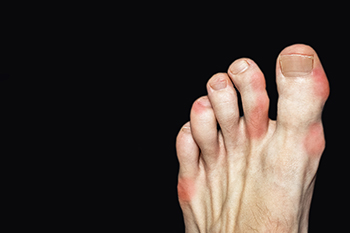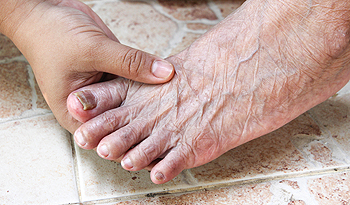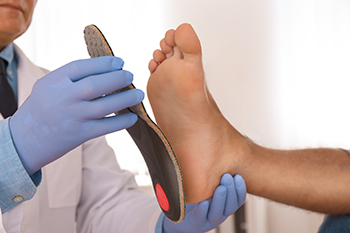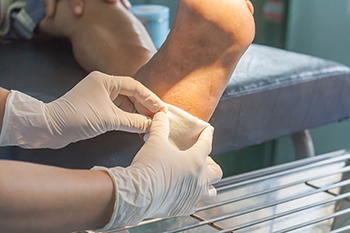Items filtered by date: August 2025
Understanding Chronic Tophaceous Gout

Tophaceous gout is a severe form of arthritis that develops in people with chronic, untreated gout. Growths, known as tophi, develop when uric acid crystals form masses around affected joints and soft tissues. These growths are often visible under the skin and can cause pain, swelling, and deformity in the feet, particularly around the toes and ankles. Over time, tophi can damage joints, reduce mobility, and even lead to disability. Tophaceous gout is caused by high levels of uric acid in the blood, which forms sharp crystals that trigger inflammation. Risk factors include a family history of gout, excessive alcohol consumption, obesity, and medical conditions like diabetes or high blood pressure. While medications to lower uric acid levels are effective in managing the condition, surgery may be required for large, painful tophi. If you have symptoms of tophaceous gout, it is suggested that you schedule an appointment with a podiatrist for ongoing management and treatment.
Gout is a foot condition that requires certain treatment and care. If you are seeking treatment, contact Joseph M. LaCava, DPM from Arkansas. Our doctor will treat your foot and ankle needs.
What Is Gout?
Gout is a type of arthritis caused by a buildup of uric acid in the bloodstream. It often develops in the foot, especially the big toe area, although it can manifest in other parts of the body as well. Gout can make walking and standing very painful and is especially common in diabetics and the obese.
People typically get gout because of a poor diet. Genetic predisposition is also a factor. The children of parents who have had gout frequently have a chance of developing it themselves.
Gout can easily be identified by redness and inflammation of the big toe and the surrounding areas of the foot. Other symptoms include extreme fatigue, joint pain, and running high fevers. Sometimes corticosteroid drugs can be prescribed to treat gout, but the best way to combat this disease is to get more exercise and eat a better diet.
If you have any questions, please feel free to contact our office located in Hot Springs, AR . We offer the newest diagnostic and treatment technologies for all your foot care needs.
Struggling With Heel Pain? Custom Orthotics Can Help

Struggling with heel pain? Discover the relief Custom Orthotics can bring. Customized to your foot's unique structure, Custom Orthotics offer targeted support, alleviating pressure points and redistributing weight. This means reduced heel pain and a more comfortable step, every time. Whether you're walking, working, or working out, Custom Orthotics ensure your heels feel cushioned and cared for. Experience the transformative power of Custom Orthotics with us today! Call today for more information.
Causes and Symptoms of Toenail Fungus

Toenail fungus, or onychomycosis, is a fungal infection that affects the toenails, often leading to noticeable changes in their appearance. Toenail fungus can cause discoloration, thickening, and crumbling of the nail, sometimes resulting in separation from the nail bed. The infection is primarily caused by dermatophytes, a type of fungus that thrives in warm, moist environments, like the inside of shoes. Factors such as excessive sweating, wearing tight footwear, nail trauma, or an existing fungal infection can increase the risk of developing toenail fungus. People with a weakened immune system or conditions like diabetes or poor circulation are at a higher risk. Symptoms of toenail fungus include discoloration, often yellow or brown, and changes in the texture of the nail. In severe cases, the nail may become painful or difficult to trim. If you notice changes in the appearance of your toenails, it is suggested that you schedule an appointment with a podiatrist for a diagnosis and appropriate treatment.
If left untreated, toenail fungus may spread to other toenails, skin, or even fingernails. If you suspect you have toenail fungus it is important to seek treatment right away. For more information about treatment, contact Joseph M. LaCava, DPM of Arkansas. Our doctor can provide the care you need to keep you pain-free and on your feet.
Symptoms
- Warped or oddly shaped nails
- Yellowish nails
- Loose/separated nail
- Buildup of bits and pieces of nail fragments under the nail
- Brittle, broken, thickened nail
Treatment
If self-care strategies and over-the-counter medications does not help your fungus, your podiatrist may give you a prescription drug instead. Even if you find relief from your toenail fungus symptoms, you may experience a repeat infection in the future.
Prevention
In order to prevent getting toenail fungus in the future, you should always make sure to wash your feet with soap and water. After washing, it is important to dry your feet thoroughly especially in between the toes. When trimming your toenails, be sure to trim straight across instead of in a rounded shape. It is crucial not to cover up discolored nails with nail polish because that will prevent your nail from being able to “breathe”.
In some cases, surgical procedure may be needed to remove the toenail fungus. Consult with your podiatrist about the best treatment options for your case of toenail fungus.
If you have any questions please contact our office located in Hot Springs, AR . We offer the newest diagnostic and treatment technologies for all your foot and ankle needs.
Relieving Plantar Fasciitis With Custom Foot Orthotics

Plantar fasciitis is a common cause of heel pain, often resulting from strain on the thick band of tissue that supports the arch. This condition can make walking or standing uncomfortable, especially first thing in the morning. Foot orthotics help by supporting the arch, redistributing pressure, and absorbing shock during movement. They ease tension on the plantar fascia and promote healing. A podiatrist can assess your foot structure, confirm the diagnosis, and design custom orthotics tailored to your specific needs. With proper support, symptoms can improve and daily activities can become more comfortable. If you have developed heel pain, it is suggested that you visit a podiatrist to explore how orthotics can provide lasting relief and restore foot comfort.
Custom orthotics are specialized shoe inserts created to support and align the feet according to each person’s unique structure and walking pattern. They are an effective way to relieve foot discomfort caused by conditions such as flat feet, high arches, plantar fasciitis, bunions, and heel pain. When the natural alignment of the foot is off balance, it can lead to pressure points, strain, and pain that affect how a person stands, walks, and moves. Orthotics work by redistributing weight evenly and supporting the arch to reduce stress on the muscles, tendons, and joints of the feet and lower legs.
Foot discomfort can develop for many reasons, including wearing improper footwear, long hours of standing, repetitive motion, or underlying structural problems. Over time, this discomfort can extend beyond the feet, contributing to knee, hip, or lower back pain. Custom orthotics help correct these issues by improving alignment and promoting more efficient movement. They are made using precise measurements and imaging to ensure the best fit for each patient, providing targeted support and cushioning where it is needed most.
Unlike generic insoles, custom orthotics are durable, medically designed, and tailored to your specific needs. Whether you are managing chronic pain, recovering from an injury, or simply seeking better comfort and stability, orthotics can make a noticeable difference in how your feet feel throughout the day.
If you are experiencing persistent foot discomfort or fatigue, it may be time to have your feet evaluated by a podiatrist. Call our office today for more information or to schedule an appointment.
If you have any questions, please feel free to contact our office located in Hot Springs, AR .
Do You Suffer From Painful Feet?
Foot Wounds and the Vital Role of a Podiatrist

A foot wound is any break in the skin of the foot that can result from injury, pressure, poor circulation, or underlying health conditions. Without proper care, these wounds may lead to infection or delayed healing. Debridement, the process of removing dead or damaged tissue, is a key step in promoting healthy tissue growth and preventing complications. A podiatrist is able to diagnose and treat foot wounds, perform debridement, monitor healing, and create individualized care plans to restore foot health. These foot doctors play a vital role in preventing infections and protecting overall mobility. If you have a foot wound or experience slow healing, it is strongly suggested that you promptly schedule an appointment with a podiatrist to receive expert care and avoid serious complications.
Wound care is an important part in dealing with diabetes. If you have diabetes and a foot wound or would like more information about wound care for diabetics, consult with Joseph M. LaCava, DPM from Arkansas. Our doctor will assess your condition and provide you with quality foot and ankle treatment.
What Is Wound Care?
Wound care is the practice of taking proper care of a wound. This can range from the smallest to the largest of wounds. While everyone can benefit from proper wound care, it is much more important for diabetics. Diabetics often suffer from poor blood circulation which causes wounds to heal much slower than they would in a non-diabetic.
What Is the Importance of Wound Care?
While it may not seem apparent with small ulcers on the foot, for diabetics, any size ulcer can become infected. Diabetics often also suffer from neuropathy, or nerve loss. This means they might not even feel when they have an ulcer on their foot. If the wound becomes severely infected, amputation may be necessary. Therefore, it is of the upmost importance to properly care for any and all foot wounds.
How to Care for Wounds
The best way to care for foot wounds is to prevent them. For diabetics, this means daily inspections of the feet for any signs of abnormalities or ulcers. It is also recommended to see a podiatrist several times a year for a foot inspection. If you do have an ulcer, run the wound under water to clear dirt from the wound; then apply antibiotic ointment to the wound and cover with a bandage. Bandages should be changed daily and keeping pressure off the wound is smart. It is advised to see a podiatrist, who can keep an eye on it.
If you have any questions please contact our office located in Hot Springs, AR . We offer the newest diagnostic and treatment technologies for all your foot and ankle needs.
Protecting Young Athletes’ Feet and Ankles While Cheerleading

Cheerleading places intense demands on the lower body, often leading to injuries such as ankle instability, Achilles tendinitis, and stress fractures in the ankle. These cheerleading foot injuries can result from repetitive jumping, hard landings, improper technique, or insufficient conditioning. Risk factors include weak ankle muscles, poor footwear, and training on hard surfaces. Symptoms include pain, swelling, or difficulty bearing weight. A podiatrist can evaluate these conditions, provide bracing, custom orthotics, and design rehabilitation plans to restore strength and prevent re-injury. If your cheerleader experiences foot or ankle pain, it is suggested that you consult a podiatrist, as prompt care is essential. This type of doctor can treat various foot and ankle injuries, and guide you on additional injury prevention tips.
Ankle and foot injuries are common among athletes and in many sports. They can be caused by several problems and may be potentially serious. If you are feeling pain or think you were injured in a sporting event or when exercising, consult with Joseph M. LaCava, DPM from Arkansas. Our doctor will assess your condition and provide you with quality foot and ankle treatment.
Common Injuries
The most common injuries that occur in sporting activities include:
- Achilles Tendonitis
- Achilles Tendon Rupture
- Ankle Sprains
- Broken Foot
- Plantar Fasciitis
- Stress Fractures
- Turf Toe
Symptoms
Symptoms vary depending upon the injury and in some cases, there may be no symptoms at all. However, in most cases, some form of symptom is experienced. Pain, aching, burning, bruising, tenderness, tightness or stiffness, sensation loss, difficulty moving, and swelling are the most common symptoms.
Treatment
Just as symptoms vary depending upon the injury, so do treatment options. A common treatment method is known as the RICE method. This method involves rest, applying ice, compression and elevating the afflicted foot or ankle. If the injury appears to be more serious, surgery might be required, such as arthroscopic or reconstructive surgery. Lastly, rehabilitation or therapy might be needed to gain full functionality in the afflicted area. Any discomfort experienced by an athlete must be evaluated by a licensed, reputable medical professional.
If you have any questions please contact our office located in Hot Springs, AR . We offer the newest diagnostic and treatment technologies for all your foot and ankle needs.

